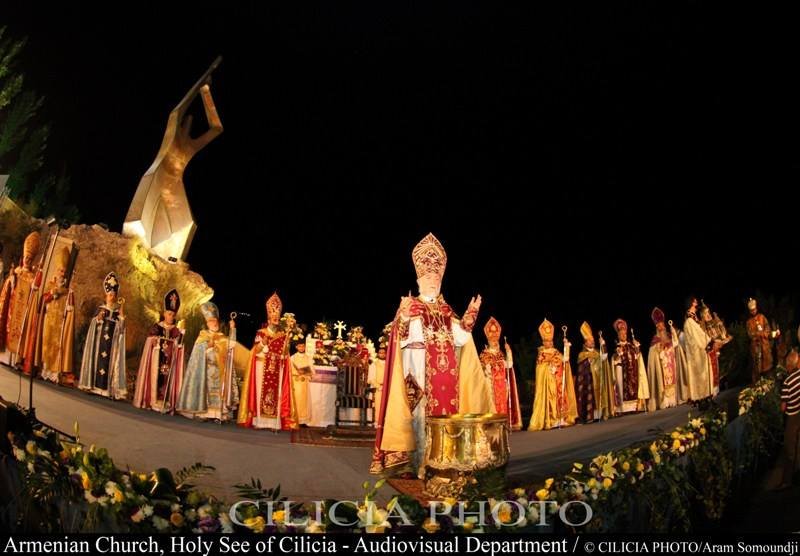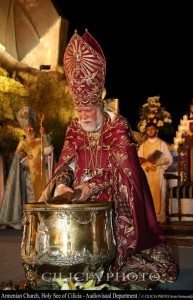Catholicos of the Great House of Cilicia His Holiness Aram I blessed the Holy Muron in a ceremony held at the Armenian Genocide Memorial at the St. Mary’s Monastery in Bikfaya, Lebanon, and attended by clergymen, ecumenical guests, diplomats, official representatives, and pilgrims from different dioceses in North and South America, Europe, and the Middle East.

In the Armenian Church, the Holy Muron is prepared and blessed every seven years. This year’s ceremony was dedicated to the memory of the 1.5 million martyrs of the Armenian Genocide and the Armenian people’s commitment to the pursuit of justice.
The ceremony began with a procession towards the Armenian Genocide Martyrs Memorial, where the ritual was held. Aram I walked towards the monument under a canopy held by four laymen representing the Armenian Diaspora. They walked behind two bishops carrying the case containing the relic of the right hand of St. Gregory the Illuminator. Four bishops carried containers of the Muron that had been brought from Holy Etchmiadzin, the old Muron from the Catholicosate of Cilicia, and rose and balsam oil. Twelve other bishops led the way.

During the blessing of the oil, Catholicos Aram I was assisted by prelates of the Dioceses of the Catholicosate of Cilicia; two representatives of the Catholicosate of Holy Etchmidadzin, Primate of the Armenian Church in Georgia Bishop Vazken Mirzakhanian, and Prelate of Georgia Bishop Vartan Navasartian; as well as two representatives from the Patriarchate of Constantinople, Archbishop Aram Ateshian, the Locum Tenens of the Patriarchate, and Bishop Sahak Mashalian.
The ceremony began with readings from the Bible. Special prayers were recited by His Holiness and the bishops. To the original mixture of oil, spices, herbs, and essence of different plants, prepared 40 days ago, His Holiness added the essence of rose and the Holy Muron from Etchmiadzin, symbolising the unity of the Armenian Church. He then added the old Muron, which is the remnant of the healing oil St. Thaddeus brought to Armenia and the Holy Muron that was blessed by St. Gregory the Illuminator. His Holiness then mixed it all in the special cauldron with the relic of the right hand of St. Gregory the Illuminator.

When the Holy Muron was blessed, His Holiness Karekin II’s message was read by the representative of Holy Etchmiadzin.
“I greet His Holiness Aram I with brotherly love. On the occasion of the blessing of the Holy Muron, we join you with our prayers and intercede with our recently sanctified martyrs and all our saints and ask God to grant us His peace, protect us and lead us to Him. The blessing of the Holy Muron is an invitation to us to renew our faith in Him, recommit ourselves to safeguarding our spiritual heritage and national identity. It is also an invitation to serve together for the glory of our Church and for the prosperity and strengthening of our homeland and the diaspora,” read a part of the message.
In his sermon, Aram I explained the special place held by the Holy Muron in the Armenian Church, especially in children’s baptisms and the ordination of priests. “Historically, the faith, love, and hope of the Holy Muron have always empowered Armenians to endure the dark days of their history, safeguard their identity, and rebuild their lives. Within the Armenian Church the Holy Muron has been the bond between the two Holy Sees,” said His Holiness.
The Catholicos concluded his message by highlighting the significance of the Centennial of the Armenian Genocide. “The blessing of the Holy Muron today, on the 100th anniversary commemorations of the genocide, is an invitation to our people to deepen their Christian faith, arm themselves with love and the power of hope in God, and continue demanding justice.”


ny thanks for the perpetuation of maintaining and providing Holy Muron so that traditions of our beliefs may be continued. Regards, Movses & Anna Movsesian, Plymouth, Mi
to whom it may concern, hello , I live in montreal,canada and I would love to see the holy muron ceremony .if you have photographed it please send me an email at salpy1963@yahoo.ca thank you , I really appreciate it ,may God bless you